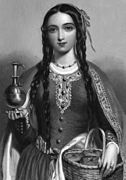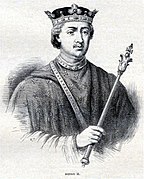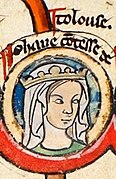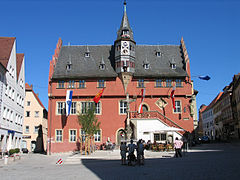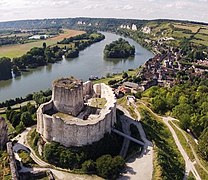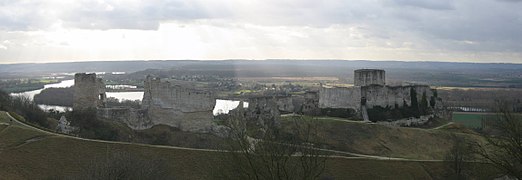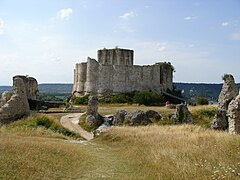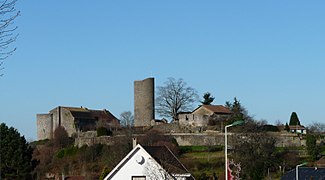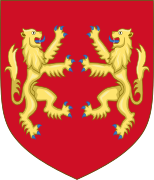Richard I of England
| Richard I "the Lionheart" | |
|---|---|
| King of England | |
 | |
| King of England | |
| Reign | 6 July 1189 – 6 April 1199 |
| Coronation | 3 September 1189 |
| Predecessor | Henry II "Curtmantle" |
| Successor | John "Lackland" |
| Regent | Queen Eleanor;William Longchamp, Bishop of Ely(Third Crusade) |
| Born | 8 September 1157 Beaumont Palace,Oxford |
| Died | 6 April 1199(aged 41) Châlus,Limousin |
| Burial | |
| Spouse | Berengaria of Navarre |
| House | House of Plantagenet |
| Father | Henry II "Curtmantle" |
| Mother | Eleanor of Aquitaine |
| Religion | Catholic Christian |
Richard I of England(8 September 1157 – 6 April 1199) was theKingofEnglandfrom 1189 to 1199. He was alsoDuke of Normandy,AquitaineandGascony,Lord ofCyprus,andCount of Poitiers,Anjou, Maine, and Nantes, and was overlord ofBrittanyat various times. He is sometimes calledRichard the LionheartorRichard coeur de lionwhich means the same thing inFrench.Richard was the son ofHenry II of EnglandandEleanor of Aquitaine.As the third son, he was not expected toinheritthethrone,and he was areplacement child.[1]At the age of 11, he becameDukeofAquitaine.
Later, Richard was one of the leaders of theThird CrusadeagainstSaladin.During his journey, he conqueredSicilyandCyprus.He fought in theSiege of Acreand theBattle of Arsuf.In the end, the crusade did not succeed: Richard was never able to win backJerusalemfrom theMuslims.He decided to return home toEngland.
On his way back from the crusade, Richard was captured byDuke Leopold of Austria.The English people had to pay a hugeransomto set him free. He was considered a brave and noble king, but he spent only six months of his eleven-year reign in England. He died after being shot with acrossbowwhilebesiegingacastleinLimousin.
King Richard’s remains wereburiedin different places.[2]His body was buried atFontevraud AbbeynearSaumurinFrance,[2]with his father and mother. His internalorganswere buried atChâlus,(atThe Château de Châlus-Chabrol), nearLimogesin central France.[2]Hisheartwas buried in the Notre Dame Cathedral atRouen.[2]
King Richard’s heart was found in 1838 and was examined by scientists in 2012.[2]They did tests forpoisons,because one medieval story claimed Richard had died from a poisonedarrow.They found no evidence to support this idea. Richard probably died fromgangreneorsepticaemiafrom the arrow wound.[2]
Richard wassucceededby his younger brother,John.
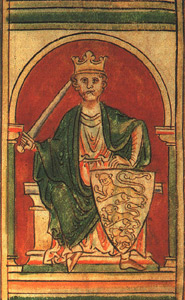
Legacy
[change|change source]Because of his military exploits his popular image is still dominated by the positive qualities ofchivalryand military competence. Contemporaries considered Richard as both a king and aknightfamed for personal martial prowess, this was apparently the first instance of such a combination. He was known as a valiant, competent military leader and individual fighter who was courageous and generous. VictorianEnglandadmired King Richard I as acrusaderand a man of God, erecting a heroicstatueof him outside theWestminster Palace.
King Richard I of England was seen as a pious hero by his subjects. He is an enduringiconicfigure both inEnglandand inFrance.
Photo gallery
[change|change source]-
King Richard I of England
-
Matilda of Scotland(1080 - 1118), Queen of England - great-grandmother of King Richard I of England
-
KingHenry II of England- father of King Richard I of England
-
Berengaria of Navarre- wife of King Richard I of England
-
Joan of England, Queen of Sicily- sister of King Richard I of England
-
Ruins ofDürnstein Castle- the first castle where King Richard was kept captive (while on his way back to England)
-
Ochsenfurt,Würzburg,Bavaria,Germany- the second place where King Richard was imprisoned (while on his way back to England)
-
Trifels Castle,Annweiler,Germany - the third place where King Richard was imprisoned (while on his way back to England)
-
Château Gaillard(The Strong Castle),Normandy,France- the most favourite residence of King Richard I of England (build by him in the years 1196 - 1198)
-
Château Gaillard
-
Château Gaillard
-
Château Gaillard
-
Château de Châlus-Chabrol(The Castle of Châlus-Chabrol),Châlus,Haute-Vienne,France- the place where King Richard I of England was mortally wounded on 25.03.1199 and subsequently died of that injury on 06.04.1199
-
Royal Arms of England (1189 - 1198)
-
Richard Coeur de Lion outside thePalace of Westminster,inLondon
King Richard I of England in the world culture
[change|change source]In 1851 German poetHeinrich Heinewrote the"König Richard"poem which was dedicated to King Richard I of England and was later translated into several languages.
|
|
|
References
[change|change source]- ↑Adam Taylor (8 September 2014)."'A spare to the heir': The weirdness of being a royal sibling ".The Washington Pose.Retrieved19 October2014.
- ↑2.02.12.22.32.42.5Morelle, Rebecca (28 February 2013)."Richard the Lionheart's mummified heart analysed".bbc.co.uk.Retrieved1 March2013.
- ↑Heinrich Heine's Sämmtliche Werke. Bibliothek-Ausgabe (The Complete Poetic Works of Heinrich Heine. Library Edition),Hamburg: Hoffman und Campe, 1885, p. 45.


